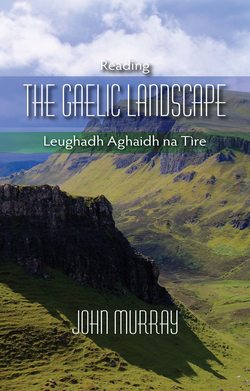Читать книгу Reading the Gaelic Landscape - John Murray - Страница 8
На сайте Литреса книга снята с продажи.
1: Introduction
ОглавлениеMany people have looked at maps of the Scottish Highlands and been intrigued, and yet excluded by the wealth of place-names they see. Most, like the English fisherman mentioned earlier, can neither understand nor pronounce the language shown on our maps. Sometimes we consult a Gaelic dictionary or Ordnance Survey’s (OS) comprehensive Guide to Gaelic Origins of Place-names in Britain. We are drawn into a complex world of strange words and spellings. Little remains for long in the mind. It is hard to apply a new vocabulary to what lies before us. Memory evaporates as there is little chance to practise our knowledge. There are few opportunities to speak the language on the Highland mainland. Given the history of discrimination against Gaelic, some native speakers are hesitant to converse with strangers. The language can be reserved for the intimacy of friends and family. So maps may be the sole contact non-speakers have with Gaelic. But, like song and poetry, they can also provide a gateway to the language. Some names are like poetry.
A sense of exclusion can be felt when any of the 46 out of the 72, 1:50000 OS maps, covering the area where Scottish Gaelic was widely spoken until the late 19th century, are consulted. This territory is known as the Gàidhealtachd (GEHaltuchk). These maps record most place-names in a roughly recognisable spelling and grammar. Many names are easy to translate without recourse to toponymic or etymological research. But Gaelic place-names cannot always be understood accurately without some knowledge of grammar.
This book builds a framework for organising knowledge to help a better recall of Gaelic toponymy. Readers will learn about many aspects of place and how these have been uniquely recorded in the language. They will perceive landscape through a Gaelic lens. Landscape will become more legible and meaningful when seen through an indigenous perception.
Place-name elements and adjectives common to many features have been organised into types. Categories cover the physical, biological, visual and cultural parts of landscape. Knowing about these name types encourages a more connected understanding of Highland landscape and culture than learning from place-name inventories alone. Some categories cover areas of interest specific to walkers, sailors, anglers, botanists and ornithologists. These will enrich understandings of landscape and place. Instead of just identifying a place, the aim is to connote a name with its meaning, in the landscape context to which it has been assigned.
The book asks questions. Why are place-name distributions often uneven for no apparent geographical reason? What happens to place-names at the edge of their cultural range? Why is the Gaelic vocabulary of place so different to English or Scots? How can Gaelic generic place words be related to geographical concepts? What kind of landscape do Gaelic names portray? What kind of plants and animals were present when names were coined? What might be the reasons why certain words are preferred to others in naming? When there are no exact translations of names, how can we know what they mean? How have poets and song writers used place-names in the Highland landscape?
A brief guide to pronunciation, which does not involve having to learn the Phonetic Alphabet, will be introduced, enabling readers to practise their knowledge. Since place-names are usually groups of nouns and adjectives, no comprehensive knowledge of Gaelic grammar will be necessary, beyond an awareness of definite and indefinite articles, plurals and genitives. Actual place-names will be used as vehicles for understanding the rules. Brief guides about the history of Gaelic, cartography and the study of place-names are included, as there are several reasons why care has to be taken in the interpretation of the mapped names.
The book will appeal to enthusiasts who seek a deeper understanding of what they study and enjoy in the Highlands. There are sections on landform, ecology, land use, water and cultural landscapes which will interest walkers, naturalists, geographers, anglers and sailors. In the emptiness of much of the mainland Gàidhealtachd, enthusiasts may now know more about the landscape than anybody else, but they may not be so well-informed about place-name meanings.
Given the decline in rural life in many areas, the book may appeal to young native speakers, whose vocabulary may no longer include words which described the working, rural landscape. What is being attempted is a semantic reclamation of a forgotten domain. An attempt to recapture a poetry of place, captured in identities given to landscape by generations of Gaels.
Past place-name publications have tended to emphasise the needs of climbers and walkers and concentrated on hills and mountains in the Highlands. This book is more extensive and so aims to attract a broader readership, enabling a wider reading of the landscape. Munro bagging might be augmented by a new sport of name-spotting.
Readers should note that place-names which are shown on OS sheets have been quoted as they are shown on maps. Some spellings are incorrect or inconsistent with today’s rules. Accents and single missing letters have been added where these are missing and the correction is simple and obvious. Where letters should be omitted, they are enclosed in round brackets. Where they should be added, they are shown in square brackets. Entirely corrected spellings are shown in square brackets. Correct and contemporary spellings of generic and specific Gaelic place-names can be found in two indexes.
